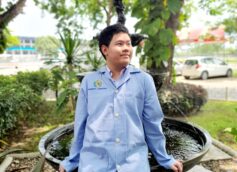heading
Contamination of wastewater with antibiotics is a critical water pollution issue due to their widespread use. Most wastewater treatment systems cannot remove these pollutants, leading to environmental contamination and increased antibiotic resistance in bacteria.
The purpose solution is a nitrogen-doped porous material from cassava rhizomes with enhanced adsorption properties for antibiotic removal.
This method, which involves using the ‘tea bag model’ and replacing hybrid porous carbon materials with magnetic nanoparticles, is not only low-cost and accessible but also designed to be user-friendly, allowing for the appropriate scaling of the porous material in the tea bags. This innovative approach presents a promising alternative for effectively treating antibiotic-contaminated wastewater, with the potential to be quickly adopted by various stakeholders.
This is how I came up with the idea for this project:Thailand, like many countries, suffers from water quality issues, especially overlooked antibiotic residue. I propose reducing antibiotics in wastewater using adsorption with porous material from modified cassava rhizomes, an agricultural waste product. This approach is beneficial both in terms of water sustainability and reducing garbage on land.
Norfloxacin Contaminated Wastewater Treatment using Porous Materials from Cassava Rhizomes: Tea Bag ModelThis research focuses on studying the efficiency of Norfloxacin antibiotic adsorption in wastewater, which is one of the most widely used quinolone antibiotics and has been reported to contaminate water sources in many countries worldwide. The study utilizes a tea bag model filled with porous material derived from Cassava Rhizomes and compares its efficiency with commercial activated carbon. The porous material from Cassava Rhizomes, which is an agricultural waste product, was developed by doping with nitrogen gas, resulting in a BET surface area, pore volume, and average pore size of 181.3 m2/g, 0.128 cm2/g, and 30.9 Å, respectively. The percentage of mesopores was 86.10%, and the carbon content was 89.16%. The adsorption efficiency for Norfloxacin reached equilibrium in 57 hours at pH 6.21and could be described by the Langmuir isotherm equation, indicating physical adsorption (R2 = 0.9886) with a Gibbs free energy of -2991.46 kJ/mol. For synthetic wastewater, the adsorption percentage was 95.287%, and for contaminated wastewater samples, it was 93.949%. Additionally, it was found that the tea bag model with porous material from Cassava Rhizomes significantly outperformed commercial activated carbon in Norfloxacin adsorption at a statistical significance level of 0.05. After six reuse cycles, the efficiency difference compared to the first adsorption was 49.39%, suggesting this method can replace hybrid porous carbon materials with magnetic nanoparticles. This method is cost-effective, easily accessible, and convenient for application, and it allows for the adjustment of the amount of porous material in the tea bag to suit the volume of wastewater. It is a promising approach to addressing water contamination, reducing the spread of antibiotics into the environment, and being environmentally friendly.

Documentation
Norfloxacin Contaminated Wastewater Treatment using Porous Materials from Cassava Rhizomes: Tea Bag Model Contamination of wastewater with antibiotics is a critical water pollution issue due to their widespread use. Most wastewater treatment systems cannot remove these pollutants, leading to environmental contamination and increased antibiotic resistance in bacteria. The purpose solution is a nitrogen-doped porous material from cassava rhizomes with enhanced adsorption properties for antibiotic removal. This method, which involves using the 'tea bag model' and replacing hybrid porous carbon materials with magnetic nanoparticles, is not only low-cost and accessible but also designed to be user-friendly, allowing for the appropriate scaling of the porous material in the tea bags. This innovative approach presents a promising alternative for effectively treating antibiotic-contaminated wastewater, with the potential to be quickly adopted by various stakeholders.

